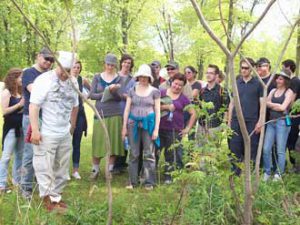
Aboriginal field course offers cultural immersion, enhanced understanding
By Pascal Zamprelli
At first, it seemed to the students that the hospital and long-term care facilities on the Kahnawake reserve did not look all that different from the Western institutions they knew. But as their tour ended, their host let them know that, now, they would dance for the elders. Before long, to a drum beat and singing, they were doing the crocodile, pumpkin and duck dances. Maybe this was different.
Twenty McGill students from Law, Social Work, and Anthropology were on the reserve to take part in a unique effort to gain a deeper understanding of Aboriginal cultures and worldviews. A five-day cultural immersion camp introduced them to Aboriginal customs, values and ways of life through activities and workshops led by facilitators from the community. The camp was part of a month-long field course designed by Nicole Ives and Michael Loft of McGill’s School of Social Work, and Courtney Montour of First Peoples’ House.
“The goals for me have always been about informing Canadians about our people, other than just what you would learn in books or in classrooms,” said Loft, himself of Aboriginal descent. Targeting students in professional disciplines whose careers may lead them to work with Aboriginal communities, the course’s immense value lay in the hands-on learning no amount of reading or studying could offer.
“It’s one thing to know something intellectually,” said Ives, but it is no substitute for experiencing something yourself. Ives paraphrased one of her students: “I’d heard that family and community were very important in Native communities. I knew that, I’d read it, but I’d never seen it. Now I understand it in my head and in my heart as well.”
The students learned the art of beading, for instance, but they also learned that beading is about more than the crafted product. “We’ve had a catastrophic history of losses, but the beading puts you in control and you can create something beautiful,” said Loft. “Intrinsically, it’s about putting order into the disorder that colonization brought to Native life.
The story of beading is also one of survival through trade, one of intense concentration, and one of sharing stories intimately with fellow crafters. In short, it’s about more than beads, a fact to which the non-Native students can now attest.
For their medicine walk, the students expected to head out far into the forest to find medicinal plants. It turned out the walk began right on their campsite, where many such plants had been under their noses for days. Their guide was a faith keeper – a member of the community whose mind is a store of knowledge passed down over centuries, on culture, language, medicines, etc. – who had them “spellbound,” in Loft’s words. The fairth keeper taught the students about medicinal properties of what seemed like almost every plant, innocuous as it might have looked. “In Western culture, the only knowledge that is produced in the world comes from double-blind studies,” said Loft. “This was a different track.”
Ives explained how notebooks usually filled with lines of text were instead filled with sketches of plants and how one law student told her that on seeing first-hand how knowledge is derived from the land, he understood land claims in an entirely different way.
This deeper understanding is precisely the purpose of the endeavour: to enhance relationships between non-Native professionals and the communities they may serve, break down the barriers of misunderstanding and build bridges. Both sides learned a lot about the other over the course of the week, and Loft hopes that initiatives such as this one may also encourage more young Natives to see themselves in these professions and pursue their studies.
“I feel that there is a much better connection and understanding between the students and Native people; we got that much closer, he said. “[The students] actually felt the spirituality that was starting to go on in the [sweat lodge, pipe, and moon] ceremonies and the activities with the elders. They were beginning to feel this thing.”
Given that success, Ives and Loft hope to offer the course again. Health Canada played a major role in funding, but there are no guarantees for next year.
“There’s another way of knowing out there,” explained Loft. “Some things are spiritual; some things are felt.”
